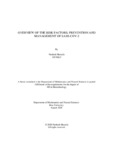| dc.contributor.advisor | Hossain, Mahboob | |
| dc.contributor.author | Mustafa, Nashrah | |
| dc.date.accessioned | 2021-06-08T05:29:03Z | |
| dc.date.available | 2021-06-08T05:29:03Z | |
| dc.date.copyright | 2020 | |
| dc.date.issued | 2020-08 | |
| dc.identifier.other | ID: 19176013 | |
| dc.identifier.uri | http://hdl.handle.net/10361/14501 | |
| dc.description | This thesis report is submitted in partial fulfillment of the requirement for the degree of Master of Science in Biotechnology, 2020. | en_US |
| dc.description | Catalogued from PDF version of thesis. | |
| dc.description | Includes bibliographical references (pages 63-82). | |
| dc.description.abstract | SARS-CoV-2, the novel corona virus that originated in Wuhan, China in late December is a
positive single stranded RNA virus. COVID-19, a disease caused by the SARS-CoV-2 is
characterized by symptoms such as fever, sore throat, dry cough, loss of sense of taste and
smell etc. The symptoms may range from asymptomatic, mild, moderate, severe and critical.
The virus enters through its spike protein (S) to the ACE2 receptors. The understanding of the
virus is crucial to devise treatment strategies and vaccines. COVID-19 disease has spread
rapidly on a global scale within a short period of time. On January 30, 2020, World Health
Organization (WHO) has identified it as a pandemic and declared it as an epidemic of
international concern. Countries went into lockdown, and different countries have adopted
various strategies to contain the disease. Non-pharmacological as well as pharmacological
treatments are being widely practiced. Treatment or management of the disease depends on
the severity of the disease. Currently, there is no single treatment, and the vaccines are still
under clinical trials. Patients with comorbidities are at higher risk for developing secondary
infections such as pneumonia. The study seeks to combine all the relevant published papers
and articles to provide an overview about the virus, highlighting its similarities and
differences with the previous variant (SARS-CoV), associated risk factors, symptoms,
available treatment strategies and finally recommendations on how to improve the current
situation. The current scenario of Bangladesh is described and three case studies are
presented in this review. | en_US |
| dc.description.statementofresponsibility | Nashrah Mustafa | |
| dc.format.extent | 82 Pages | |
| dc.language.iso | en_US | en_US |
| dc.publisher | Brac University | en_US |
| dc.rights | Brac University theses are protected by copyright. They may be viewed from this source for any purpose, but reproduction or distribution in any format is prohibited without written permission. | |
| dc.subject | Pandemic | en_US |
| dc.subject | COVID-19 Disease | en_US |
| dc.subject | Treatment strategies | en_US |
| dc.subject | Vaccine | en_US |
| dc.subject | SARS-CoV-2 | en_US |
| dc.title | Overview of the risk factors, prevention and management of SARS-COV-2 | en_US |
| dc.type | Thesis | en_US |
| dc.contributor.department | Department of Mathematics and Natural Sciences, Brac University | |
| dc.description.degree | M. Biotechnology | |

